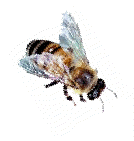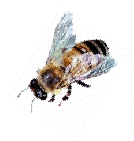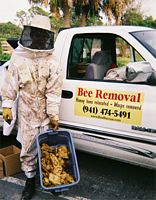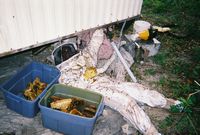



Bee Removals -- What we do and how we do it.
We are committed to protecting the environment and do not use toxic pesticides.
We use various techniques to remove the bees, alive and unharmed, and relocate them to safe places for humans and bees. Most removals involve vacuuming the bees off the comb into a special box. Then the comb is removed by cutting and scraping

--a very hot, messy job, with honey dripping on our heads, faces and arms, and bees crawling all over us. We face the dangers of rattle snakes, recluse spiders,black widow spiders, and scorpions hiding under mobile homes, in sheds, and under soffits. Sometimes we have to lie in stinging fire ants while removing the bees. Temperature inside our bee suits can exceed 120 degrees F., in the summer.
(Click To enlarge the pictures. Use Browser back button to return)We also use a laser thermometer to find the nest by it's heat. Bees keep the nest at 95 degrees

We put down drop clothes to keep the messfrom dripping onto floors. After the comb is removed we wash the area with detergent to remove as much of the bee pheromone as possible. The scent of bees can last for years and acts as an attractant to other bees, causing recurring infestations if not treated.
Sometimes we use a heat gun to melt and remove wax from hard to reach places. Then, where the comb was attached we apply an oily repellent that repels new bees from building comb in the same place.
After we finish the removal, we take the bees to our apiary (bee yard) and shake them into a hive box with combs and hope they survive the ordeal, to continue their beneficial work. To control Africanized bees, we place them in a quarantine hive with a queen excluder. This keeps the drones from mating and we replace the queen with a European bred Queen. In three weeks she replaces the Africanized workers with her gentle daughters.